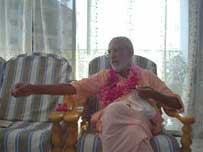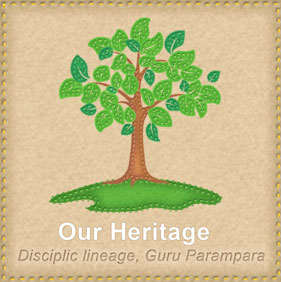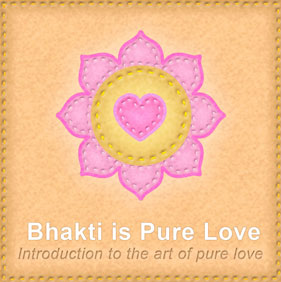Sri Kesavaji Gaudiya Math:
Koladvipa, Navadvipa-dhama: March 17, 2005
Sri Srimad Bhaktivedanta Narayana Maharaja
What is the glory of Navadvipa? The original Supreme Personality of Godhead Sri Krsna appeared in this world and performed His astonishing pastimes in Vrndavana. Yet, all of His desires were not fulfilled at that time. Those desires that were not fulfilled by Him during His pastimes in Vrndavana were fulfilled when He appeared here in Navadvipa-dhama in the form of Sri Caitanya Mahaprabhu. In Vrndavana He tasted prema as the object of the prema (pure love of God) of His devotees, but He did not know how the devotees felt in their love for Him. He could not taste what they experience in their loving mood. Also, in Gokula (Vrndavana manifest in this world), He did not distribute prema to one and all. It is only here in Navadvipa-dhama that He – as Sri Caitanya Mahaprabhu – so freely distributed it. He tasted the prema of the reservoir of love, His devotees, and especially the prema of Srimati Radhika, and He also distributed prema – especially the prema of Radhika’s maidservants.
Not only did Sri Caitanya Mahaprabhu distribute this to the devotees who had become qualified by their practices, but even to those who were fallen and offensive. When He was on His way to Vrndavana He came to Kasi, and there He gave mercy to the leader of the mayavadis, Prakasananda Sarasvati – and not only to him, but also to his 60,000 sannyasa disciples. He is the most merciful incarnation. In other incarnations if anyone was opposed to Krsna, He would take up His weapon and kill him. But Sri Caitanya Mahaprabhu never did so. Rather, He purified the hearts of the offenders through the chanting of the holy names and bestowed upon them love of God. Here in Navadvipa-dhama, He gave His mercy to the most sinful Jagai and Madhai, and so many others. He caused an inundation of transcendental love and made everyone dance.
After taking sannyasa, Caitanya Mahaprabhu went to Jagannatha Puri, and there He met with Sri Sarvabhauma Bhattacarya, who was a leader of themayavadis, those who are very much antagonistic to the cult of pure devotion. He also gave mercy to him and converted him. When He was in South India, traveling here and there, He was so merciful that all the living entities, even those who saw Him from very far away, became overwhelmed with prema.
So many pastimes of Sri Caitanya Mahaprabhu took place here in Navadvipa. He also spent many years in Jagannatha Puri. He also went to South India, to the bank of the Godavari, where He met with Sri Raya Ramananda and had very confidential discussions. Of these three abodes of the Lord – Navadvipa, Jagannatha Puri and Godavari – which one is superior? Nowadays there is a great deal of confusion about this topic. Many people are convinced about the wrong understanding, because the real philosophical conclusion is very deep and difficult to understand.
Navadvipa-dhama, where we have now come, is highest.*[See endnote] This place is superior to both Jagannatha Puri and Godavari. Why? There are so many reasons.
Someone may say that Jagannatha Puri is the highest place, because it was there in the Gambhira that Mahaprabhu relished vipralamba rasa (the mood of separation; Srimati Radhika’s separation for Sri Krsna) and fulfilled His three desires. But Jagannatha Puri is a manifestation of Dvaraka Puri. Otherwise, according to Mahaprabhu’s mood, He would also see it as Kuruksetra and become absorbed in the meeting of Radha and Krsna there. We cannot say that it is Vrndavana. In Vrndavana there are twelve forests, such as Vrndavana, Kumudvana, Bahulavana, Kelanvana, etc. Where are they in Jagannatha Puri? We cannot find them. On the other hand, here in Navadvipa-dhama, all the twelve forests of Vrndavana are present. This place in which we are now situated is called Koladvipa. Koladvipa is non-different from Giriraja-Govardhana, and very close by is Syama-kunda and Radha-kunda. Where is Syama-kunda and Radha-kunda in Jagannatha Puri? Very close by here is Panca-veni, which is superior to Prayag. At Prayag the Yamuna, Ganga and Sarasvati rivers meet. But here, Yamuna, Ganga, Sarasvati, Alakananda, Godavari, Kaveri, Sindhu, Narmada and all the other holy rivers meet. We call it Panca-veni, the meeting of five holy places or holy rivers, but don’t think there are only five. Thousands upon thousands – all the sacred rivers – have descended and are meeting together here at Panca-veni in Navadvipa. In Jagannatha Puri the ocean is a maha-tirtha (great holy place), because Caitanya Mahaprabhu bathed the transcendental body of Srila Haridasa Thakura there. But even the ocean came here to Navadvipa-dhama at Samudragadha ghat (bathing place). So this place is superior to Prayag.
Navadvipa-dhama is called gupta (hidden) Vrndavana, because all the pastime places of Vrndavana, like the rasa-sthalis (the areas of the rasa dance), Giriraja-Govardhana, Syama-kunda, Radha-kunda - all twelve forests - are here in a hidden way.
Another important point: Lord Krsna’s eternal pastimes (nitya-lila) in Vrndavana are called asta-kaliya-lila.The 24-hour day of Sri Sri Radha and Krsna is divided into eight parts, beginning with nisanta-lila (pre-dawn pastimes), pratah-lila (morning pastimes), purvahna-lila (forenoon pastimes), madhyana-lila (midday pastimes), aparahna-lila (afernoon pastimes), sayama-lila (dusk pastimes), pradosa-lila (evening pastimes) and ratri-lila (nighttime pastimes). Just as Sri Sri Radha-Krsna performed Their asta-kaliya-lila in Vrndavana, Sri Gauranga, Sri Caitanya Mahaprabhu, performed His asta-kaliya-lila here in Navadvipa-dhama.
Is it mentioned in any scripture that He performed His asta-kaliya-lila in Jagannatha Puri? Does He perform His asta-kaliya-lila in Godavari? There is no mention. His nitya-lila, the origin or root of all His pastimes, takes place here in Navadvipa-dhama. Sri Caitanya Mahaprabhu remembers the nisanta-lila of Radha and Krsna at the end of the night and becomes overwhelmed in ecstasy. Then later, early in the morning he goes with His friends to take bath in the Ganga. In His ratri-lila, He performs His sankirtana rasa. In this way He performs His asta-kaliya-lila, completely absorbed in the asta-kaliya-lila of Radha and Krsna.
Another reason for the superiority of Navadvipa-dhama is as follows. Even though Jagannatha Puri and Godavari are very levated, transcendental abodes, there is aisvarya-mayi-lila (pastimes in opulence and majesty) there. There, Sri Caitanya Mahaprabhu was worshipped as God. In Godavari He manifested His form as Rasaraja-mahabhava, Sri Sri Radha and Krsna combined as one, and this pastime is also aisvarya-mayi-lila. In Jagannatha Puri He performed pastimes in the Gambhira, but only Sri Svarupa Damodara, Sri Raya Ramanada, Sri Sikhi Mahiti and His sister Srimati Madhavi devi – 3 1/2 intimate associates – could take part. Here in Navadvipa-dhama, on the other hand, His pastimes are madhurya-mayi-lila (sweet, human-like), not aisvarya-mayi-lila. Here, Sri Sacinandana Gaurahari meets in lokika sadbhanduvat sambhanda (natural, family-like relationships) with all the residents. When we try to understand if a particular pastime is superior to others, the ultimate measure is whether that pastime is purely madhurya. Madhurya-lila are those pastimes resembling sweet, human-like activities with human-like relationships, without out any trace of the mood of aisvarya. And, even if any of those pastimes would be full of opulence, they would be seen as human-like by the Lord's associates.
Thus, this dhama is so exalted and extraordinary, so superior to every other place of Mahaprabhu’s pastimes. Srila Raghunatha dasa Gosvami prays:
yat kincit trna-gulam kikata mukham gosthe samastam hi tat
sarvanandamayam mukunda dayitam lilanukulam param
sastrair eva muhur muhuh sphutam idam nistankitam yacnya
brahmader api sasprhena tad idam sarvam maya vandyate
[“With great longing I worship all the living entities of Vraja including the grass, bushes, flies, and birds, which are filled with transcendental bliss. There fortune is so great that it is aspired for by personalities like Sri Brahma and Uddhava. Srimad Bhagavatam and other sastras have repeatedly and clearly propounded their glories. They are very dear to Sri Mukunda and assist in His pastimes.” (Raghunatha dasa - Stavavali, Vraja-vilasa-stava, 102)]
“I pray to all the living entities of Vrndavana, including the grass, bushes, insects and birds.” This verse is also applicable to Navadvipa-dhama. Every living entity here – every tree and creeper – is sat-cit-ananda, made of eternity, full knowledge and bliss, and they assist the Lord’s pastimes. Therefore, even great personalities such as Lord Brahma have prayed to become stones and blades of grass in such an unprecedented and transcendental abode.
Who can realize these truths? Our previous acaryas, Srila Jagannatha dasa Babaji Maharaja and Srila Gour Kisora dasa Babaji Maharaja, can do so. They used to give respects even to the dogs of this abode. Srila Jagannatha dasa Babaji Maharaja used take his prasadam with puppies, who were eating from his plate. He used to say, “Oh, they are the dogs of Navadvipa-dhama”. Our acaryas illustrated through their lives what kind of very high level of respect one should have in approaching this extraordinary place.
Sri Caitanya Mahaprabhu lived here in the house of Sacimata in Mayapura, in Antardvipa. He performs His pastimes here, and after 24 years He took sannyasa and went to Jagannatha Puri and so many other places. However, even when He takes sannyasa and appears to this leave this dhama, He’s still present here. Only those who are extremely fortunate and whose love is mature can realize how He always performs His pastimes here in this transcendental place, and how He never leaves.
Sri Navdvipa-dhama ki jaya!
[*Endnote – The following is another lecture by Srila Narayana Maharaja on the same subject, given a few years ago in Australia:
Sri Srimad Bhaktivedanta Narayana Maharaja
THE SUPREMACY OF NAVADVIPA
Murwillumbah, Australia: Feb. 13, 2002
Now I will begin Jaiva Dharma, first chapter, which is about nitya and naimittika-dharma. Nitya-dharma means transcendental, eternal dharma (religion), and naimittika-dharma means temporary dharma. Srila Bhaktivinoda Thakura is explaining that Prthivi-loka, the Earth, is the most superior planet in the entire universe. There are so many lakhs and lakhs of planets, and lakhs and lakhs of suns, moons and twinkling stars, and it may be that these stars are even greater than the suns and moons, but Prthivi-loka is most superior among all of them. This is because Krsna, Rama, and all other incarnations appeared in this land.
There are seven islands or continents in this Prthivi, and the most superior among them is Jambudvipa, where there was a very big tree of jambu (blackberries). That black tree is actually Vrndavana's tamala tree, and tamala is actually Tamala Krsna. Krsna is there in Jambudvipa.
In Jambhudvipa, the most superior place is Bharatavarsa. First, its name was Ilavrta-varsa, but due to the famous king Bharata Maharaja, who was dedicated to Krsna and who attained liberation in three births, it became known as Bharatavarsa. Amongst 100 brothers, Bharata was the King, and he was superior to his 99 brothers.
In Bharatavarsa, Gauda-bhumi is the most superior place, and Gauda-bhumi includes five tracts of land. For example, the first is the land between the Yamuna River and the Sindhu Rivers, in Punjab; the land between the Ganges and the Yamuna rivers, Kanyakubja, is the second; and the land passing through Ayodhya, between the Ganges and Gomati rivers where Salagrama is found, is the third Gaura. The place in which Sri Caitanya Mahaprabhu took birth is the fifth Gauda, and therefore, among the five Gauda-bhumis, Navadvipa is the best place.
What is the meaning of Navadvipa? The nine islands denote the nine processes of bhakti.
sravanam kirtanam visnoh
smaranam pada-sevanam
arcanam vandanam dasyam
sakhyam atma-nivedanam
"Hearing and chanting about the transcendental holy name, form, qualities, paraphernalia and pastimes of Lord Visnu, remembering them, serving the lotus feet of the Lord, offering the Lord respectful worship with sixteen types of paraphernalia, offering prayers to the Lord, becoming His servant, considering the Lord one's best friend, and surrendering everything unto Him (in other words, serving Him with the body, mind and words)." (SB 7.5.23)
This Navadvipa has been addressed as Svetadvipa in the Vedas, Upanisads and so many other Vaisnava literatures.
sriyah kantah kantah parama-purusah kalpa-taravo
druma bhumis cintamani-gana-mayi toyam amrtam
katah ganam natyam gamanam api vamsi priya-sakhi
cid-anandam jyotih param api tad asvadyam api ca
sa yatra ksirabdhih sravati surabhibhyas ca su-mahan
nimesardhakhyo va vrajati na hi yatrapi samayah
bhaje svetadvipam tam aham iha golokam iti yam
vidantas te santah ksiti-virala-carah katipaye
"I worship that transcendental seat known as Svetadvipa, where as loving consorts the Laksmis in their unalloyed spiritual essence practice the amorous service of the Supreme Lord Krsna as their only lover; where every tree is a transcendental purpose tree; where the soil is the purpose gem, all water is nectar, every word is a song, every gait is a dance, the flute is the favorite attendant, effulgence is full of transcendental bliss and the supreme spiritual entities are all enjoyable and tasty, where numberless milk cows always emit transcendental oceans of milk; where there is eternal existence of transcendental time, who is ever present and without past or future and hence is not subject to the quality of passing away even for the space of half a moment. That realm is known as Goloka only to a very few self-realized souls in this world." (Brahma-samhita 5.56)
Srila Rupa Gosvami has quoted this verse, and Srila Bhaktivinoda Thakura has also quoted it, along with many such verses. Navadvipa is Svetadvipa. In transcendental Goloka Vrndavana there are two parts: Vrndavana and Svetadvipa. Vrndavana and Navadvipa are parasistha, complementary. Without Navadvipa, Vrndavana is incomplete, and without Vrndavana, Navadvipa is incomplete. Together they are complete, as when separation and meeting mix together, the resultant situation is complete. Where there is no separation mood, sanyoga (meeting) is incomplete.
The twelve vanas (forests) and upavanas of Vrndavana are in Navadvipa, within the nine islands: Madhuvana, Talavana, Kumudvana, Bahulavana, Kamyavana, Kadirvana, Badhravana, Bandhirvana, Baelvana, Mahavana, Vrndavana, and Mahavana. All of these forests, in some way, are in Navadvipa.
Don't think that Jagannatha Puri is superior to Navadvipa. Don't think that Godavari-tata, where Mahaprabhu revealed His form and mood of Rasaraja-Mahabhava, is superior to Navadvipa. Navadvipa is far superior to both these places. On one hand, Sri Caitanya Mahaprabhu revealed His transcendental form of Rasaraja-mahabhava at Godavari, and that most high class of hari-katha, Raya Ramananda Samvad, took place there. On one hand, Caitanya Mahaprabhu showed His extreme moods of separation in Gambira. He jumped in the ocean near there, and He relished Srimati Radhika's moods of separation with Svarupa Damodara and Raya Ramananda there. This may be said, therefore, to be the deepest and highest hari-katha, but there are so many reasons why it is not.
Jagannatha Puri is a very elevated pastime place, especially regarding the Gambira-lila of Sri Caitanya Mahaprabhu, but still it is like Dvaraka. There is no forest or sub-forest of Vrndavana there. Neither Gokula, Bandhiravana, Nandagaon, or Varasana are there. These forests are not in Godavari-tata, neither are they in Kuruksetra or Jagannatha Puri. Therefore, Navadvipa must be superior to these places.
Because so many places of Vrndavana are there in Navadvipa in a hidden way, Navadvipa is known as Gupta-Vrndavana. One of the nine islands of Navadvipa is Godrumadvipa, and this island is described by Srila Bhaktivinoda Thakura in his Jaiva Dharma. Godrumdvipa is Nandagaon, nearby Varsana.
The birthplace of Caitanya Mahaprabhu in Mayapura is Mathura and Gokula combined. Caitanya Mahaprabhu is Krsna, with the internal mood and complexion of Srimati Radharani. Krsna took birth in Vrndavana; partly in Mathura, but fully in Gokula, and both places are combined there in Mayapura Yogapitha.
Crossing Ganga from there to Koladvipa, where our Devananda Gaudiya Matha is situated, we find Giriraja-Govardhana. There, all the kunjas and caves in which Krsna played with the sakhas and sakhis are situated. Nearby there is Rasauli, or Rasa-sthali, where Chandra-sarovara is located at the foot of Giriraja-Govardhana. Nearby there is Rthudvipa, where Radha-kunda and Syama-kunda are situated, and that is Kokhilvana. Our Devananda Gaudiya Matha was constructed by our Gurudeva on the West bank of the Ganges, the bank where Yamuna flows. Mayapura is on the East bank of Ganges, where the Ganges itself flows, and Lord Brahma performed thousands and thousands austerities on that Ganges bank.
In Navadvipa there is Pancaveni, the meeting place of the Ganges, Yamuna, Sarasvati, Godavari, Narmada, and Sindhu, and Manasi Ganga is also there. Radha-kunda and Syama-kunda are there, and this is all very wonderful. In Mamagaci (Modadrumadvipa) Bhandiravat is present, and Jahnudvipa is Bhadravana. All these truths have been explained by Srila Bhaktivinoda Thakura in his Sri Navadvipa Dhama Mahatmya; Vrndavana is in Navadvipa, not in Jagannatha Puri or Godavari.
There is one very important thing to know, and I am explaining it for those who are senior Vaisnavas. They will be able to understand. Junior devotees should note it down, and they should also try to understand. You should know these things very deeply. With regards to Navadvipa being Vrndavana, there are two asta-kaliya-lilas. One is Sri Caitanya Mahaprabhu's asta-kaliya-lila and one is Radha and Krsna's asta-kaliya-lila. Mahaprabhu's asta-kaliya-lila takes place in Navadvipa, and it is that asta-kaliya-lila upon which devotees meditate. They do not meditate on such lilas in Jagannatha Puri.
In their gaura-gayitri mantra, the brahmanas chant, "Gauraya." Why do they utter, "Gauraya"? Who is Gaura? Gaura, or Gauranga, is Krsna, with the intrinsic mood and beauty or golden color of Radhika, and He is actually Krsna, but now He is fully absorbed in the mood of Radhika. He feels as though He has become Radhika. But there are three Radhikas. One is Vrsabhanuja or Vrsabhanunandini Radhika, one is Viyogini Radhika, and one is Sanyogini Radhika.
Vrsabhanunandini Radhika never goes out of Vrndavana, and Krsna and Rohininandana Rama are always in Vrndavana. If Rama and Krsna are coming towards Mathura, they will turn back to Vrndavana at the borderline. Rohininandana Rama cannot go out of Vrndavana, because He always remains with Krsna. Only Their manifestations, Vasudevanandana Krsna and Vasudevanandana Baladeva, will go to Mathura and Dvaraka. The pastimes of Krsna in Mathura and Dvaraka are transcendental and everlasting, as are the pastimes of Vrajendranandana Krsna in Vrndavana. Vasudeva Krsna plays eternally in Mathura, and in Vrndavana, Vrajendranandana Krsna plays eternally.
Similarly, there are three Radhikas. Actually there is only one Radhika, but She has three moods or three features. Krsna will not change when He goes to Mathura, but He will not use His flute and peacock-feather. He will change His father and mother, but not His form. Only His mood will be changed, and mood is the prominent factor of determination. If He takes His flute and peacock-feather, and He tells everyone, "I am the son of Nanda and Yasoda," then He is Vrajendranandana Krsna. On the other hand, if He has no peacock-feather and flute and He tells everyone, "I am the son of Vasudeva and Devaki," then His is present by His prakasa (manifestation). His manifestation is not fully the Supreme Krsna Himself.
In the same way, Vrsabhanunandini Radhika is always with Krsna in Vrndavana. In Nandagaon, where Radhika felt so much separation and spoke Brahmara-gita, She is Viyogini Radhika. Actually, She is never in viyoga, in the sense that she is never separated from Krsna. Srila Rupa Gosvami has explained this truth in his Lalita-Madhava and also in Ujjvala Nilamani, and that is why Kavi Karnapura has not discussed the lila of Mathura and Dvaraka. He completes his Ananda Vrndavana Campu just after rasa-lila. Our acaryas can never tolerate the idea that Radhika should be separated from Krsna. In Her original and complete feature She is called Vrsabhanunandini. She is always with Nandanandana Krsna, and the Radhika who feels separation in Nandagaon is Her manifestation, Viyogini Radhika. She is the same Radhika, but She is feeling viyoga. Then, in Kuruksetra, She is Sanyogini Radhika. She goes there for a moment, for one or two days and, keeping Krsna on the chariot of Her mind, She brings Him back to Vrndavana. Sanyoga means 'always meeting.'
In the mantra 'tan no gaura pracodayat', the name Visvambhara is uttered. Visvambhara never lived in the cave (Gambhira) in Jagannatha Puri, for He is Sacinandana Gaurahari in Navadvipa. From there He gives so much knowledge, so much love and affection, and a very high-class prema to the jivas. 'Visvambharaya dhimahi' means that we meditate on Him in Navadvipa.
In the cave of Gambira, Mahaprabhu played a role of great opulence. At that time, in the night, no one but Raya Ramananda and Svarupa Damodara (Visakha and Lalita) were able to witness His pastimes. At that time, although he was always hearing and knowing all Mahaprabhu's pastimes, even Srila Rupa Gosvami could not go there. In Godavari, Mahaprabhu manifested His form as Rasaraja-Mahabhava. This is opulence. At that time, even Ramananda Raya began to pray like Devaki or Arjuna, "O, You are that same Supreme Personality of Godhead." This is opulence.
In Navadvipa, however, there is no opulence. In Navadvipa, Sacinandana played as Krsna played with the girls in Vrndavana. While bathing in the Ganges He would say to the little girls, “Will you marry me? I want to marry you. If you will not marry Me, you will not be happy. Give your offerings of sandesa and bananas to Me." This comes in the category of the asta-kaliya-lila of Caitanya Mahaprabhu, and it is therefore far superior to any lila in Jagannatha Puri. In Navadvipa there is svarasikhi-upasana (meditation and worship of the continual flow of unlimited lilas taking place throughout each twenty-four hour day), whereas in Puri there is mantramayi-upasana (meditation and worship of a specific lila, in this case Srimati Radhika's separation feelings for Krsna).
Now we're going in Godrumadvipa, which is Nandagaon, where Premadasa Babaji performed his bhajana. What is Godruma? Go-druma. The druma means a very big pipal (aswattha) tree, and 'go' refers to the Surabhi cow. After Krsna's pastimes, she brought Indra to this place and performed thousands and thousands years of austerities in order to receive the darsana of Sri Caitanya Mahaprabhu. At last she received His darsana, when He was performing nagara-sankirtana in mahabhava. It was also in this place that Surabhi gave milk to Markendeya Rsi. So Navadvipa-dhama is not an ordinary or general place. It is the most superior place.
Srila Bhaktivinoda Thakura has an abode there in Nandagaon, Ter Kadambha, which is so glorious because unlimited very sweet pastimes took place there. During the day Krsna used to play on His flute, calling, "Shamali, Davali, Gange, Yamune, Pisange," and thousands and thousands of cows used to meet Him there. During the night His flute called, "Radhe, Lalite, Visakhe!" and they all came to Him. Srila Bhaktivinoda Thakura preferred Godrumadvipa, just as Srila Rupa Gosvami preferred to have his bhajana-sthali in between Nandagaon and Yavat. Godruma is the same as that Ter Kadambha in Nandagaon. Antardvipa is Mahaprabhu's janmasthana and also Krsna's janmasthana, Gokula and Mathura. But Srila Bhaktivinoda Thakura preferred Nandagaon, because Radha's and Krsna's separation and meeting are both present there.
Let us now go to Godruma. You should all come with me, offer your pranama in Godruma-kunja, the place of Srila Bhaktivinoda Thakura's bhajana-sthali and samadhi, and then we can begin Jaiva Dharma.
[Devotee:] In Kuruksetra, Radharani felt separation from Krsna, even though They were meeting there. Why is She called Sanyogini there, since 'sanyogini' means 'always meeting'?
[Srila Narayana Maharaja:] They are never separated. For lila, They appeared to be separated.
radha krsna-pranaya-vikrtir hladini saktir asmad
ekatmanav api bhuvi pura deha-bhedam gatau tau
caitanyakhyam prakatam adhuna tad-dvayam caikyam aptam
radha-bhava-dyuti-suvalitam naumi krsna-svarupam
"The loving affairs of Sri Radha and Krsna are transcendental manifestations of the Lord's internal pleasure-giving potency. Although Radha and Krsna are one in Their identity, They separated Themselves eternally. Now these two transcendental identities have again united, in the form of Sri Krsna Caitanya. I bow down to Him, who has manifested Himself with the sentiment and complexion of Srimati Radharani although He is Krsna Himself." (Cc Adi 1.5)
They have become two for lila-rasa, but They are one, and in this way They are always meeting. In meeting there is also separation, and this is called madanakya-maha-bhava.
[Sripad Asrama Maharaja:] Is Saccinandana Gaurahari tasting madankya-maha-bhava in prakrata-lila, in Navadvipa, in Srivasa Angam and other places?
[Srila Narayana Maharaja:] Yes, He was, but it was in His heart. Srila Bhaktivinoda Thakura has explained this, as has Caitanya-caritamrta. Those who will go deep can collect these truths everywhere. Without madanakya-maha-bhava, He is not Caitanya Mahaprabhu. He has become Saccinandana Gaurahari especially for tasting this mood. It was especially for this.
[Sripad Asrama Maharaja:] He is tasting this in Svetadvipa, but is He also tasting it in prakata-lila?
[Srila Narayana Maharaja:] Yes, either in seed or prakata (externally manifest); everywhere it will be so].
Translator: Prem Prayojan das
Transcriber: Radha-kanta dasa and Sripad Sajjana Maharaja
Editor: Syamarani dasi
Typist: Savitri dasi and Radhika dasi
Proof-reader: Vasanti dasi









